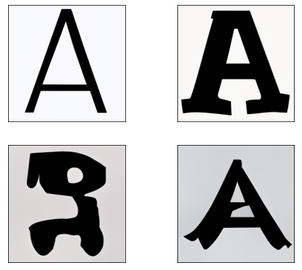#8 + #9 Can a diffusion model generate two different letters at once?
In experiments #8 and #9, I trained the diffusion model with all the data I had created so far. This means that images with both the letter A and the letter g were trained in the same model at the same time to see if the model could distinguish between them or if it mixed the properties of the letters.
To do this, I first colour-coded the two letters in experiment #8, which in this case means colouring all A‘s in all font categories in blue and all g‘s in red. This should make it easier for the model to tell the two letters apart. The results are clear. The model generates blue letters that look like an A and red letters that look like a g, with few exceptions. A mixture is not recognisable either in the shapes or in the colours.
In experiment #9, the aim is to find out whether this is due to the colour coding. For this purpose, the same data set in black and white was used as training data. It is not really possible to recognise a mixing of the two letters. Only these forms, which occur in this experiment, could be interpreted as such. The diffusion model can therefore recognise that these are two different forms. How it behaves with other letters or other letter combinations cannot be dealt with in this project. The following creations are relevant to me as a designer.
Diffusion Models can generate more complex letters and work out and represent the characteristics of the letter from diverse training data. In addition, the model has learned to distinguish between two different letters.






Comments